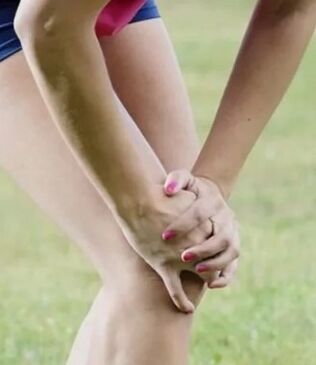The first stage of osteoarthritis of the knee jointDespite sometimes intensive pain, at the beginning, at the first stage of gonarthrosis, the knee bones retain their original shape and are almost not distorted. But the joint itself may seem a little swollen.Such a change in form of the articulation at the beginning can be associated with a synovitis (synovitis is an accumulation in the knee of a pathological liquid).
If the articulation fluids are too "won", it even spreads to the back of the knee, towards the area of the popliteal pit. Such accumulation of liquid is called baker cyst. The term "baker cyst" often scares patients, because the name leads many people to the idea that we are talking about the oncological process. However, this state has nothing to do with oncology and tumors. The baker cyst is only a term meaning the accumulation of fluid in the knee. Sometimes, when it accumulates too much of this liquid, it breaks under the knee and below - at the back of the lower leg. But even in this case, nothing terrible occurs: the baker cyst is generally easily reduced under the influence of anti-inflammatory drugs or the introduction of hormonal drugs in the knee. As a result, the Baker cyst must be treated. But in no case do I need to make it work!The second stage of osteoarthritis of the knee jointIn the second stage of gonarthrosis, a few months later, from the start of the disease, knee pain becomes clear. The pain is already occurring from the minimum load or immediately after.In other words, the pain is now caused by almost all movements in the affected knee. But above all the knee hurts after a long load, long walk, even carrying small weights. After a fairly long rest, the pain usually goes completely, but during the next movement, it reproduces immediately.Around the same time, a crunch in the knee joint during movements is added to pain. It differs considerably in volume from barely audible clicks, sometimes accompanying individual movements of healthy joints.As the disease progresses, such a crunch, expressed firstly weakly, becomes more audible and distinct.I want to emphasize once again: it is not necessary to confuse a crunchy crude arthritis in the joint, almost always accompanied by pain, with a crunchiness harmless of joints who occur in some healthy people and not accompanied by pain.The soft and painless softness of the joints can only be a consequence of the low ligament apparatus, or an excessive mobility of the joints or other individual characteristics in the structure of the joints in a given person. As a rule, such a gentle crunch does not threaten anything, has no negative consequences and does not increase the risk of joint diseases in the future. Osteoarthritis of the knee joint, arthritis, meniscus damage, etc.In addition to strengthening pain and the appearance of cryst, the second stage of gonartrose, the ability to fold the leg normally into the knee decreases. When you try to bend the knee "stopped", there is acute pain in the joint, and more often, the complete flexion of the knee simply becomes impossible. Sometimes the knee is only folded at a corner of 90 degrees, then goes with difficulties and by pain.At the same stage of the disease, it becomes notable that the joint is distorted - first of all, this applies to bone deformations, to changes in the shape of the joint bones (when you feel the knee, you can notice that its bones have changed their shape, became as wider and "coarse"). In addition, the change in the form of the joint is aggravated by the accumulation in the joint of the pathological liquid (synovitis). Synovitis at this stage of gonarthrosis occurs much more often and sometimes much more expressed than at the start of the disease, at its first stage.The third stage of osteoarthritis of the knee jointIn the third stage of gonartrose, knee pain in the knee is still intensified. Now the knee hurts not only during moving and walking. The pain begins to disturb a person even at rest. It is difficult for the patient to find a practical position in bed, to organize an affected knee so that he does not hurt. And yet, finding the right position, a person can usually fall asleep. Although, if the destruction of the joint is combined with circulatory disorders, the joints begin to "twist" in the middle of the night, generally when you change the weather, or, as patients themselves, "rain".The mobility of the knee joint at this time is reduced to a minimum. The knee is already completely impossible to look stronger than 90 degrees. And sometimes the knee almost does not fold at all. In addition, the opportunity often disappears at the end, that is to say straightening the leg. In this case, a sick person walks on legs slightly folded all the time.Compared to the second stage, at the third stage of the joint gonarthrosis, the joint is even more distorted, and in some cases, the deformation of the legs "varior" or "valgus" develops - the legs acquire a shape in the form of O or in the shape of X. Consequently, people with similar deformations of the legs often become unstable.




















